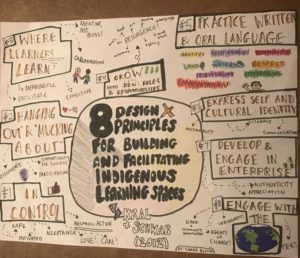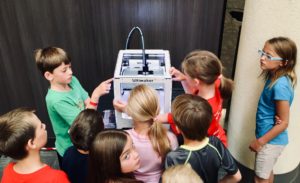
While I believe ensuring “equitable access to authentic, meaningful and relevant learning environments for all learners in K-12 open and distributed learning contexts” needs to be an ongoing, lifelong process where educators gain more knowledge and experience every day, I have learned a lot on this subject from this week’s #EDCI339 readings.
As discussed by Selwyn in his piece for Monash University, online education is now more than ever “taking on a more prominent role” as school systems navigate education during a global pandemic (2020). This means that all students need to have equitable access to their learning and we as educators must know how to provide that for them. We must teach the whole child and take into account all of the previous learning experiences that make them unique. Making sure learners have resources that represent them (what they look like, what their family looks like, their gender identity, race, ethnicity, heritage, culture, etc.) is crucial to their comfort and psychological safety in the classroom. This week, one reading that I particularly enjoyed was “Design Principles for Indigenous Learning Spaces” by Kral & Schwab.
In their piece, Kral & Schwab identify eight design principles for “building or facilitating [Indigenous] learning spaces” (2012, p.58). Click here to listen to an audio file where I speak about these principles based on the sketchnote below. Here is the transcript for that audio file accompanied by citations and references.

Universal Design for Learning needs to be woven into all equitable systems of learning. In their article, Basham et al. reflect on UDL and how it can help all learners when implemented properly into online education. While UDL was initially created as a technique for including learners with diverse learning designations and special needs into the “typical” classroom, it is now being used as a way to include all students and their unique variabilities (Basham et al., 2018, p.477).
 The “three core principles” of UDL (multiple means of engagement, multiple means of action and expression, and multiple means of representing information) are used to “address the academic, social, and cultural distinctions that exist in today’s schools” (Basham et al., 2018, p.480). UDL aligns closely with the ideologies behind open and distributed learning because of its focus on “harnessing technology and instructional practices to remove barriers in curricula and across digital as well as physical learning environments” (Basham et al., 2018,p.480). Interestingly, the results of UDL in brick and mortar schools looks vastly different to that in open and distributed learning contexts. To learners with “disabilities, cultural impoverishment, and ELLs,” there are often “insurmountable barriers” present due to the “inaccessible rigidity of online learning materials and practices” (Basham et al., 2018, p.479). By making sure that online resources are personalized and student-centred, UDL guidelines can often be met (Basham et al., 2018, p.489). Every year, educators and school systems are becoming more and more “knowledgeable of the importance of addressing the diversity in today’s digital environments,” because of this, access and equity have also increased; however, we still have work to do (Basham et al., 2018, p.492).
The “three core principles” of UDL (multiple means of engagement, multiple means of action and expression, and multiple means of representing information) are used to “address the academic, social, and cultural distinctions that exist in today’s schools” (Basham et al., 2018, p.480). UDL aligns closely with the ideologies behind open and distributed learning because of its focus on “harnessing technology and instructional practices to remove barriers in curricula and across digital as well as physical learning environments” (Basham et al., 2018,p.480). Interestingly, the results of UDL in brick and mortar schools looks vastly different to that in open and distributed learning contexts. To learners with “disabilities, cultural impoverishment, and ELLs,” there are often “insurmountable barriers” present due to the “inaccessible rigidity of online learning materials and practices” (Basham et al., 2018, p.479). By making sure that online resources are personalized and student-centred, UDL guidelines can often be met (Basham et al., 2018, p.489). Every year, educators and school systems are becoming more and more “knowledgeable of the importance of addressing the diversity in today’s digital environments,” because of this, access and equity have also increased; however, we still have work to do (Basham et al., 2018, p.492).

While this article provides research-based evidence on UDL in open and distributed learning environments, I have a question for practicing educators today. What are some tried and true, effective methods of online instruction involving UDL that can be used to make the world of open and distributed learning more accessible and equitable for all learners?
References
Basham, J.D., Blackorby, J., Stahl, S. & Zhang, L. (2018) Universal Design for Learning Because Students are (the) Variable. In R. Ferdig & K. Kennedy (Eds.), Handbook of research on K-12 online and blended learning (pp. 477-507). Pittsburgh, PA: Carnegie Mellon University ETC Press.
Kral, I. & Schwab, R.G. (2012). Chapter 4: Design Principles for Indigenous Learning Spaces. Safe Learning Spaces. Youth, Literacy and New Media in Remote Indigenous Australia. ANU Press. http://doi.org/10.22459/LS.08.2012 Retrieved from: http://press-files.anu.edu.au/downloads/press/p197731/pdf/ch041.pdf
Selwyn. N. (2020). Online learning: Rethinking teachers’ ‘digital competence’ in light of COVID-19. [Weblog]. Retrieved from: https://lens.monash.edu/@education/2020/04/30/1380217/online-learning-rethinking-teachers-digital-competence-in-light-of-covid-19

alexamclean
Feedback for EDCI339:
WOW! I love this post! You really crafted an amazing multimedia resource. I think your use of the articles to support your own arguments was expertly done. I love your sketch note and the audio and transcript that accompanied it. This in itself was using UDL guidelines of multiple means of representation. Something to make it even better would be to link the UDL website or chart. Overall, I think this is your best post yet! Amazing job!
laurenmclean
Feedback for EDCI 339:
Sarah I thought this was a fantastic blog post! I loved how you used multiple forms of multimedia to help convey your ideas and still remain within the word limit (I may have to do something similar for my assignment three). I think this already shows that you have the out of the box thinking required to implement UDL in your classroom and how to authentically integrate multi mediums. I liked that you kept the overall tone of the post to be “student centred learning” and educating the whole child. I think it allowed the integration of all of the readings to make sense. One way to improve could be linking the UDL website so one could look further into the core principles and guidelines to gain a full understanding of what it may look like in the classroom. Overall a BEAUTIFUL post!
hgus123
Feedback for EDCI 339:
I am always amazed by how detailed and insightful your blog posts are Sarah! You did an excellent job of integrating the readings, as well as, providing your own thoughts and ideas on the topics. I love the sketch note you created of the eight design principles and how you are incorporating concepts we learned in EDCI 337 to enhance your posts. As a reader, it makes it very enjoyable to interact with your blog and maintain engagement. I really have nothing to say that could be fixed or done differently and I agree with Alexa that this is your best post so far! If you are wanting to make slight adjustments, I would consider reading through the post out loud and maybe shortening some of the sentences for flow. Fantastic job!